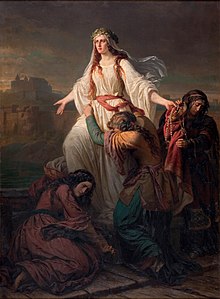| Princess Wanda | |
|---|---|
 | |
| Father | Krakus |

Princess Wanda (reputedly lived in 8th century Poland) was the daughter of the Lechitic King Krakus, legendary founder of Kraków. Upon her father's death she became a princess of the Poles, but committed suicide to avoid an unwanted marriage.
Legend
The first written record of the legend of Wanda was made by the Polish chronicler Wincenty Kadłubek, which historians believe to be an invented legend. In this version of the story Wanda ruled Poland after her father, when her lands were invaded by an "Alamann tyrant". Wanda led her troops out to meet him. Seeing her beauty, the German troops refused to fight and their leader committed suicide. Towards the end of the story Kadłubek states that "the river Vandalus is named after" her and hence the people she ruled over were known as "Vandals". In this version Wanda remained unmarried and had a long life.
Subsequent versions of the story differ significantly. In the version from the Wielkopolska Chronicle, the Alemannic leader, Rytygier (Rüdiger), first wanted to marry Wanda and invaded her lands when she refused. Here, he died during the ensuing battle, while it was Wanda who committed suicide afterwards, as thanks and a sacrifice to the pagan gods who gave her victory. In yet other versions of the story, Wanda commits suicide by throwing herself into the Vistula river, because she knows there will be future suitors who will use her refusal to marry as a pretext for an invasion. This variation was popularised by the 15th-century historian Jan Długosz.

Cultural influences
Wanda Mound (Polish: Kopiec Wandy) is assumed to be the burial place of the princess. Up until the 19th century, bonfires were lit at the mound on Pentecost. The nearby industrial district of Nowa Huta, established on 1949, began construction on the name day of Wanda (23 June). As such, Princess Wanda is a semi-official patron of the district, which contains a trade center, street, bridge, and stadium named after her.
The German poet Zacharias Werner wrote a drama named Wanda, which under Werner's friend Goethe was performed on stage in 1809.
The story of Wanda is very popular in Polish art, culture and literature. For example, the Polish poet C.K. Norwid visited the Mound in 1840 and subsequently composed the epic narrative poem Wanda in honor of the ancient Polish princess and queen.
Wanda (also spelled as Vanda) outside of Poland - Vanda the title and protagonist of the 1876 Antonín Dvořák grand opera, Wanda; the protagonist of the 1809 stage play Wanda written by German poet Zacharias Werner and directed by Johann Wolfgang von Goethe; Wanda, heroine of the 1840 narrative poem "Wanda" by the Polish poet C. K. Norwid; Wanda, subject of the 1868 play Wanda, the Polish Queen by the Croatian dramatist Matija Ban; Wanda von Dunajew, protagonist of Leopold von Sacher-Masoch's 1870 novel Venus in Furs; Wanda von Chabert, the protagonist of the 1881 Guy de Maupassant story "In Various Roles"; "Kinda Fonda Wanda" a song by Neil Young on his 1983 album Everybody's Rockin'.

Antonín Dvořák composed the fifth of his 11 operas, the tragedy Vanda around this episode in Polish history legends. Writing in 1875, he cast the story as a struggle between the pagan West Slavs and the Christian Teutons.
In 1890, a statue designed by the Polish artist Jan Matejko depicting an eagle turning to the west was mounted on top of the mound. On the base of the statue the inscription WANDA was carved, together with two swords and a distaff.
References
- "Wanda", The Dinner Party, Elizabeth A. Sackler Center for Feminist Art, Brooklyn Museum
- ^ K. Kumaniecki, "Podanie o Wandzie w świetle źródeł starożytnych", Pamiętnik Literacki [pl] 22–23 (1925–26).
- K. Römer, Podanie o Kraku i Wandzie, Biblioteka Warszawska 1876
- Vincent Kadlubek legend of Wanda, who lived in the land of the Wandalen, Vandals, page 56,57
- Jacek Banaszkiewicz, "Rüdiger von Bechelaren, którego nie chciała Wanda. Przyczynek do kontaktu niemieckiej Heldenepik z polskimi dziejami bajecznymi", Przegląd Historyczny [pl], 75, 1984
- Wanda Archived 2007-10-22 at the Wayback Machine, Alkor.
Further reading
- Anstruther & Sekalski, Old Polish Legends, Hippocrene Books; 2nd edition, May, 1997.
- Kraków District Guide, OAG Cities Guides, 2007.
- Cabras, Francesco. 2016. “The Legend of Wanda in Jan Kochanowski’s Elegy I 15”. In: Studi Slavistici 12 (February), 59–77. https://doi.org/10.13128/Studi_Slavis-17969.
External links
| Polish legendary rulers | |
|---|---|
| These rulers supposedly ruled in the Early Middle Ages. |
| Monarchs of Poland | |
|---|---|
| Legendary | |
| Proto-historic (before 966) | |
| Piast dynasty (966–1138) | |
| Fragmentation period (1138–1320) | Senior or Supreme Princes
|
| Přemyslid dynasty (1296–1306) |
|
| Restored Piast dynasty (1320–1370) | |
| Capet-Anjou dynasty (1370-1399) | |
| Jagiellonian dynasty (1386–1572) | |
| Elective monarchy (1572–1795) | |
| Duchy of Warsaw (1807–1815) | Frederick Augustus I |
| Romanov dynasty (1815–1917) | |
| |